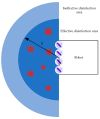An Autonomous Mobile Combination Disinfection System
- PMID: 38202915
- PMCID: PMC10780396
- DOI: 10.3390/s24010053
An Autonomous Mobile Combination Disinfection System
Abstract
To address the common drawbacks of current disinfection robots, which include the potential for secondary environmental pollution, disinfection dead corners, and low efficiency, in this paper, an autonomous mobile combination disinfection system is proposed. The system utilizes ultraviolet (UV) radiation and a low-concentration hydrogen peroxide aerosol to kill pathogens. It comprises three parts: a human-computer interface, a mobile robot, and disinfection equipment. A disinfection process model with continuous and fixed-point modes was established, and the effective disinfection range, speed, and duration were quantitatively calculated. The developed prototype was tested on-site by a professional third-party testing agency. The experimental results demonstrated that the combination disinfection robot achieved a 92.95% disinfection rate of natural airborne bacteria in a room measuring 22 square meters with a height of 2.8 m in just 30 min. The disinfection efficiency is at least 25% higher compared to standalone UV lamp disinfection and also exhibits a noticeable improvement over standalone hydrogen peroxide aerosol disinfection. The system enables the environmentally friendly, rapid, efficient, and all-encompassing disinfection of natural airborne bacteria. Finally, various disinfection solutions and recommendations for different application scenarios and requirements are provided.
Keywords: UV; aerosol; autonomous mobile robot; combination disinfection; disinfection efficacy.
Conflict of interest statement
The authors declare no conflict of interest.
Figures









Similar articles
-
RoboCoV Cleaner: An Indoor Autonomous UV-C Disinfection Robot with Advanced Dual-Safety Systems.Sensors (Basel). 2024 Feb 2;24(3):0. doi: 10.3390/s24030974. Sensors (Basel). 2024. PMID: 38339691 Free PMC article.
-
A pilot study on the disinfection efficacy of localized UV on the flushing-generated spread of pathogens.J Hazard Mater. 2018 Sep 15;358:389-396. doi: 10.1016/j.jhazmat.2018.07.003. Epub 2018 Jul 3. J Hazard Mater. 2018. PMID: 30005250 Free PMC article.
-
Evaluating different concentrations of hydrogen peroxide in an automated room disinfection system.Lett Appl Microbiol. 2016 Sep;63(3):178-82. doi: 10.1111/lam.12607. Epub 2016 Jul 26. Lett Appl Microbiol. 2016. PMID: 27324207
-
Modern technologies for improving cleaning and disinfection of environmental surfaces in hospitals.Antimicrob Resist Infect Control. 2016 Apr 11;5:10. doi: 10.1186/s13756-016-0111-x. eCollection 2016. Antimicrob Resist Infect Control. 2016. PMID: 27069623 Free PMC article. Review.
-
The in situ efficacy of whole room disinfection devices: a literature review with practical recommendations for implementation.Antimicrob Resist Infect Control. 2022 Dec 5;11(1):149. doi: 10.1186/s13756-022-01183-y. Antimicrob Resist Infect Control. 2022. PMID: 36471395 Free PMC article. Review.
Cited by
-
Ultraviolet C Decontamination Devices in a Hospital Pharmacy: An Evaluation of Their Contribution.Pharmacy (Basel). 2025 Jan 25;13(1):9. doi: 10.3390/pharmacy13010009. Pharmacy (Basel). 2025. PMID: 39998007 Free PMC article.
References
-
- WHO WHO Coronavirus (COVID-19) Dashboard with Vaccination Data. 2022. [(accessed on 1 March 2023)]. Available online: https://covid19.who.int/
-
- Zhao Y.-L., Huang H.-P., Chen T.-L., Chiang P.-C., Chen Y.-H., Yeh J.-H., Huang C.-H., Lin J.-F., Weng W.-T. A smart sterilization robot system with chlorine dioxide for spray disinfection. IEEE Sens. J. 2021;21:22047–22057. doi: 10.1109/JSEN.2021.3101593. - DOI
-
- Wen S.S., Zuo W.C., Zhou Y., Ye Q.N., Tan D.H., Chen X.D. Research status and development trend of ultraviolet disinfection technology. Opt. Tech. 2020;46:664–670. doi: 10.13741/j.cnki.11-1879/o4.2020.06.006. (In Chinese) - DOI
MeSH terms
Substances
Grants and funding
LinkOut - more resources
Full Text Sources
Medical

